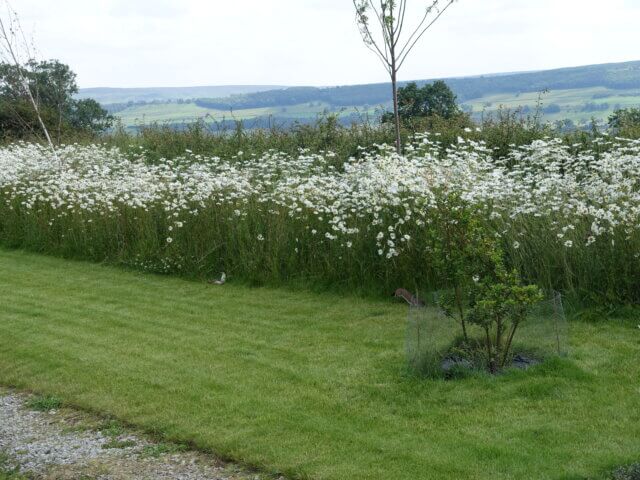Meadows are a type of grassland habitat, so by definition they should contain a good proportion of grasses. Grasses are fundamental to the health of these habitats. Grasses play a vital role in offering structural support, texture, and ecological balance. They also support biodiversity, providing food and habitats for numerous species, including birds, insects and mammals. Grasses however in the right environment will naturally colonise and can overpower slower growing wildflowers.
If grasses become too dominant they will prevent the wildflowers from growing, reducing the diverse ranges of plant life, which is vital for a meadow’s overall health.
2024 truly has been the year of the grasses, presenting many with an unprecedented challenge: grass dominance. So, why has this surge occurred, and what steps can we take to manage it effectively?
Why Are Grasses So Prominent This Year?
In 2023/2024, we have seen cooler temperatures combined with excess rainfall which has created the perfect storm for grass growth. Stafford Council have reportedly experienced “the wettest Winter since 1835”! The excessive rainfall in the past year has created the optimal growing conditions to support the rapid growth and spread of grasses, not only in wildflower areas but habitats across the country.
As grasses have shallow roots and aggressive spreading habits, it gives them a competitive edge over slower growing wildflowers. Better suited for growth in wetter, cooler conditions, in some cases this can lead to a dominance of grasses and reduce the number of biodiverse species within the wildflower area.
What Can be Done to Manage Grass Dominance?
Proactive steps taken now can help prevent grasses from overshadowing your meadow in future years.
1) The Chelsea Chop
One effective method to manage grass dominance is the Chelsea Chop. Typically done in late May/early June, however this year (2024), this can be done until end of July. Cut back 20-30cm ensuring to clear all the cuttings. By cutting back the grasses, the sward opens up allowing sunlight and rain to reach shorter and overshadowed wildflower species and will help to deplete unwanted fertility in that area. A cut and remove will rebalance the variety in your sward and extend the flowering season. As we approach the end of the growing season for most grass species, doing a high cut now will help remove excess nutrients and grass seeds.
A high cut and remove may be needed a few times to help remove nutrients – less nutrients, less grass.
Top tip: If you carry out the high cut during warmer weather, the wildflowers should respond better to the rise in temperature and grow quicker. The open sward from the high cut and remove will provide space and light required for growth.
2) Enhance Grass Control
Known as a ‘meadow maker’, Yellow Rattle is a semi-parasitic plant which reduces grass dominance by feeding on the roots of grasses. Yellow Rattle can be introduced by sowing seed, or by installing our new innovative product, Enhance Grass Control.
3) Spot treatment
Hand picking any unwanted grasses is an effective chemical free alternative to managing grass dominance. After a cut and remove to 6-10cm, isolating the species, use a fork or similar tool to pull out the grasses by the roots, ensuring complete removal. This method is an easy, herbicide-free option.
Another option to manage grass dominance is through spot spraying. This approach involves selectively applying herbicides or treatments to specific areas to manage grass growth without affecting the surrounding vegetation. Ensure to cut back 6-10cm so that species are isolated ensuring good coverage of the target species with the chemical. Use a herbicide or treatment specifically designed for the type of grass you need to control. Note that for this method, an agronomist and a commercial chemical license will be required.
Given the unusually wet year we’re all experiencing, adopting strategies such as the Chelsea Chop or introducing Yellow Rattle can help to control grass growth and support your wildflowers. By implementing these techniques, you can maintain a diverse wildflower meadow despite the challenging conditions.
Don’t lose hope! These photos, taken a year apart, demonstrate the remarkable transformation achieved by implementing these management techniques.


Remember wildflower meadows vary year after year. A grass-heavy year doesn’t guarantee the same for the next. That’s why we love them!